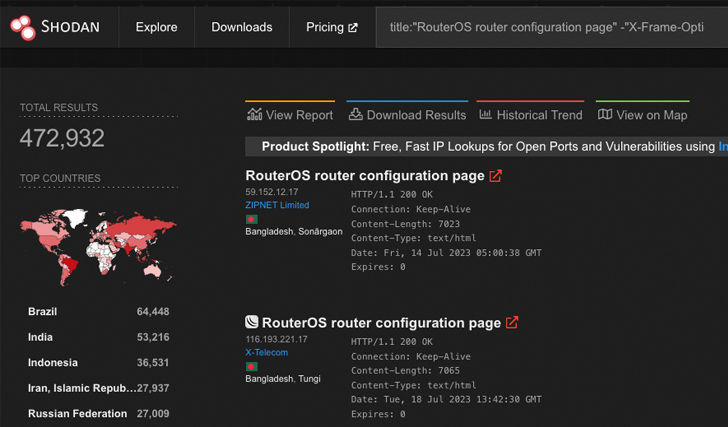A severe privilege escalation issue impacting MikroTik RouterOS could be weaponized by remote malicious actors to execute arbitrary code and seize full control of vulnerable devices.
Cataloged as CVE-2023-30799 (CVSS score: 9.1), the shortcoming is expected to put approximately 500,000 and 900,000 RouterOS systems at risk of exploitation via their web and/or Winbox interfaces, respectively, VulnCheck disclosed in a Tuesday report.
“CVE-2023-30799 does require authentication,” security researcher Jacob Baines said. “In fact, the vulnerability itself is a simple privilege escalation from admin to ‘super-admin’ which results in access to an arbitrary function. Acquiring credentials to RouterOS systems is easier than one might expect.”
This is because the Mikrotik RouterOS operating system does not offer any protection against password brute-force attacks and ships with a well-known default “admin” user, with its password being an empty string until October 2021, at which point administrators were prompted to update the blank passwords with the release of RouterOS 6.49.
CVE-2023-30799 is said to have been originally disclosed by Margin Research as an exploit dubbed FOISted without an accompanying CVE identifier in June 2022. The security hole, however, was not plugged until October 13, 2022, in the RouterOS stable version 6.49.7 and on July 19, 2023, for the RouterOS Long-term version 6.49.8.
VulnCheck noted that a patch for the Long-term release tree was made available only after it directly contacted the vendor and “published new exploits that attacked a wider range of MikroTik hardware.”
A proof-of-concept (PoC) devised by the company shows that it’s possible to derive a new MIPS architecture-based exploit chain from FOISted and obtain a root shell on the router.
Shield Against Insider Threats: Master SaaS Security Posture Management
Worried about insider threats? We’ve got you covered! Join this webinar to explore practical strategies and the secrets of proactive security with SaaS Security Posture Management.
“Given RouterOS’ long history of being an APT target, combined with the fact that FOISted was released well over a year ago, we have to assume we aren’t the first group to figure this out,” Baines noted.
“Unfortunately, detection is nearly impossible. The RouterOS web and Winbox interfaces implement custom encryption schemes that neither Snort or Suricata can decrypt and inspect. Once an attacker is established on the device, they can easily make themselves invisible to the RouterOS UI.”
With flaws in Mikrotik routers exploited to corral the devices into distributed denial-of-service (DDoS) botnets such as Mēris and use them as command-and-control proxies, it’s recommended that users patch the flaw by updating to the latest version (6.49.8 or 7.x) as soon as possible.
Mitigation advice includes removing MikroTik administrative interfaces from the internet, limiting the IP addresses administrators can login from, disabling the Winbox and the web interfaces, and configuring SSH to use public/private keys and disable passwords.

